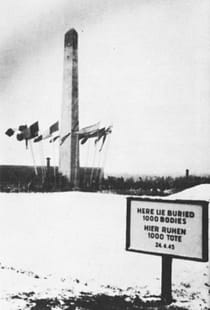Dimbleby’s subsequent respect for the stability of established procedures, the security of an evolving history, and the consolation of organised religion derives from Belsen. His own eyes had witnessed what happens when human order disintegrates and man reverts to animal. He was to revisit Belsen twice:
In the summer of 1959 we were filming in Germany for the series ‘After the Battle’, in which six war correspondents returned to areas to which they had been assigned during the war. The last of the six was Richard Dimbleby, whose area was Germany, from Cologne through to Berlin. From Hanover we travelled one wet Sunday morning to Belsen. Richard was in his own car – a new Rolls – which appeared to be having gear box trouble to such an extent that, when he did arrive, he commented, ‘If the wretched thing had got any worse I should have been forced to travel in reverse’.
On the camp-site at Belsen most of the film team went off to reconnoitre, leaving Richard and myself sitting in his car. It was the first time that he had been back since 1945. We sat there in silence for nearly 15 minutes and it was only too clear what emotions the place was stirring in him. The huge mass graves bearing the stark inscriptions, ‘Here lie buried 1,000 bodies’ and so on were all around us – more than enough to evoke the most bitter memories of 19 April 1945, the day on which he first entered the camp. He suddenly turned to me and said, ‘Do you know what’s strange about this place?’ I thought for a moment or two – there was nothing particular that I could pick out. ‘No.’ ‘There isn’t a single bird singing here.’ With that he relapsed once more into silence – a silence which only ended with the arrival of the rest of the team some minutes later, and the return to the demands of the present time.

